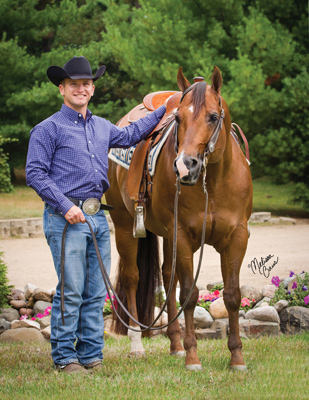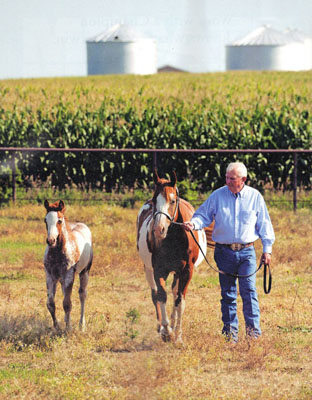 This marks the sixth breeding season since the Great Recession gripped the United States in 2008. There is no question, the economic downturn unseated the horse industry. Since 2008, breed associations have experienced fewer registrations.
This marks the sixth breeding season since the Great Recession gripped the United States in 2008. There is no question, the economic downturn unseated the horse industry. Since 2008, breed associations have experienced fewer registrations.
Although 2013 figures have not been released for all associations, three of the major breed associations have reported declining registrations from 2007 through 2012. In 2007 the Appaloosa Horse Club registered 5,945 horses and in 2013 it registered 2,654. The American Paint Horse Association registered 35,032 horses in 2007 and 12,815 in 2012. And the American Quarter Horse Association recorded 135,787 registrations in 2007 and 84,001 in 2012.
“The overall supply of performance horses has declined,” says Rebecca Hogan, owner of Appaloosa stallion, Spot My Blue Boy, “people have chosen not to breed.”
The industry has steadily trended toward a more selective breeding attitude.
“With a decrease in disposable income, people are much less inclined to take risks on unproven or mediocre mares or stallions,” Raina Parsons, manager at Reisinger Farms, says, “it is expensive to raise horses and there are enough variables to consider even without factoring in a lack of quality in your breeding stock. 2014 falls right in line with that trend of decreased numbers of horses being bred.”
Stallion bookings for 2014 are down at Reisinger Farms, owned by Gregg Reisinger, the No. 1 APHA Lifetime breeder who stands Mr. Zip O Rock, Zippin Rock, Alotta Charisma and Bet Your Chip in Eldora, Iowa. “We have decreased our broodmare band from 80 mares to about 40,” Parsons explains, “our breeding program is shifting toward few mares of higher quality.”
 Not only do buyers have less disposable income to spend on buying horses, breeders are feeling the pinch of rising expenses. “You’re lucky if you make the breeding fees and vet fees back,” Cindy Howard of Howard Quarter Horses says. “Breeding is a labor of love, you have to love raising horses.”
Not only do buyers have less disposable income to spend on buying horses, breeders are feeling the pinch of rising expenses. “You’re lucky if you make the breeding fees and vet fees back,” Cindy Howard of Howard Quarter Horses says. “Breeding is a labor of love, you have to love raising horses.”
Catherine Dunnagan adds, “I don’t think the horse industry is doing well at all.” She currently stands Appaloosa stallion, Always In the Mood, at her farm in Fulton, New York. She’s been breeding for over 20 years and has always held a job off the farm to help offset the expenses of maintaining a stallion and broodmares. “I try to convince people not to breed unless they have a really quality horse,” she adds.
Breeding trends over the past decade have followed historical demand and supply curves mirroring the economic climate. Historically, registration increases and decreases can be directly attributed to the repeal of the favorable equine tax law in the 1980’s; oil prices that hit highs in 1981 and 2007, and lows in 1988, 1994 and 1998; stock market record highs from the late 1990’s to 2007.
Light at the end of the tunnel?
AQHA Membership trended downward again in 2013 to 270,000, AQHA Executive Vice President, Don Treadway reported at the 2014 Convention in New Orleans last month. In 2013, breed association memberships totaled 372,891, while AQHA memberships totaled 270,700, giving AQHA a 65 percent market share. “The good news is, we are getting a bigger piece of the pie,” he said.
F ewer foals in the marketplace will eventually lead to a shortage for competitors looking to buy. “I think those who breed are going to make a lot of money and when people look to replace the older horses, the people that have them will get paid for them,” Eric Petersen says.
ewer foals in the marketplace will eventually lead to a shortage for competitors looking to buy. “I think those who breed are going to make a lot of money and when people look to replace the older horses, the people that have them will get paid for them,” Eric Petersen says.
Petersen stands Getting Impulsive, AQHA stallion, at his farm in Cannon Falls, Minnesota. “Bookings are up this year compared with previous years,” he says. And, Petersen plans to breed the entire broodmare band he owns in partnership with his father.
Hogan agrees that 2014 will be stronger for Spot My Blue Boy, standing this year at Dry River Ranch in Weatherford, Texas. “Unfortunately it’s been difficult to get started because of the economic environment and he was a new stallion,” she says, “but he has produced well and is gaining momentum. I sold out of his babies this past year and plan on breeding all of my mares this year (eight-10). The economy is slowly getting better. I am optimistic.”
Larger breeders too, are hopeful for the 2014 season. “The breeding climate has definitely been on the increase over the past two years,” says Christi Christensen, breeding manager for High Point Performance Horses. “I believe that 2014 will be our biggest season yet.”
The farm stands several stallions including VS Flatline (AQHA), Slick By Design (AQHA), VS Code Red (AQHA), The Big Sensation (APHA), Hot Ones Only (AQHA) and Hubba Hubba Huntin (AQHA).
Typically, High Point Performance Horses receives breeding contracts after the holidays. Contracts for the 2014 breeding season began arriving in August 2013.
“It’s exciting to have people anxious to breed again. Sales on horses are up and so are the number of breedings,” says Christensen.
In addition to earlier breeding contracts, she has noticed an increased number of first-time breeders calling. “In my opinion I think breeders are more open to breeding now. I have had numerous customers call that have never bred, but want to get an embryo out of their show mares or have retired a mare and want to try breeding for the first time.”
 Geography no longer dictates who a mare can be bred to. Easy access to stallions across the country can be a blessing and a curse for stallion owners.
Geography no longer dictates who a mare can be bred to. Easy access to stallions across the country can be a blessing and a curse for stallion owners.
“With such widely available access to cooled semen breeders are getting much more selective about the stallions they are using on their mares,” Parsons acknowledges.
Anyone can open a magazine or journal and hand-pick a stallion from anywhere in the country that suits their taste.
“Horse breeders are no longer bound by geography,” she adds, “When people make an investment in these animals they want to eliminate as much margin for error as possible. When you breed two outstanding individuals there is no guarantee of success, but your odds sure get better.”
What’s it all mean?
It’s difficult to predict the future of the breeding industry. New figures for 2013 are due out this month from associations like the AQHA but one thing seems certain – breeders and buyers are selective, searching for the most talented prospects.
“This is true whether you are breeding or selling,” Parsons says. “I think it’s wise to be plugged in to the market of the horses you are producing. When that market fails to exist all you are doing is saturating the industry with unwanted horses. As a business, we need to put out a product that is in high demand, and to achieve that goal you must start with the very best mares and the very best stallions,”



You must be logged in to post a comment Login